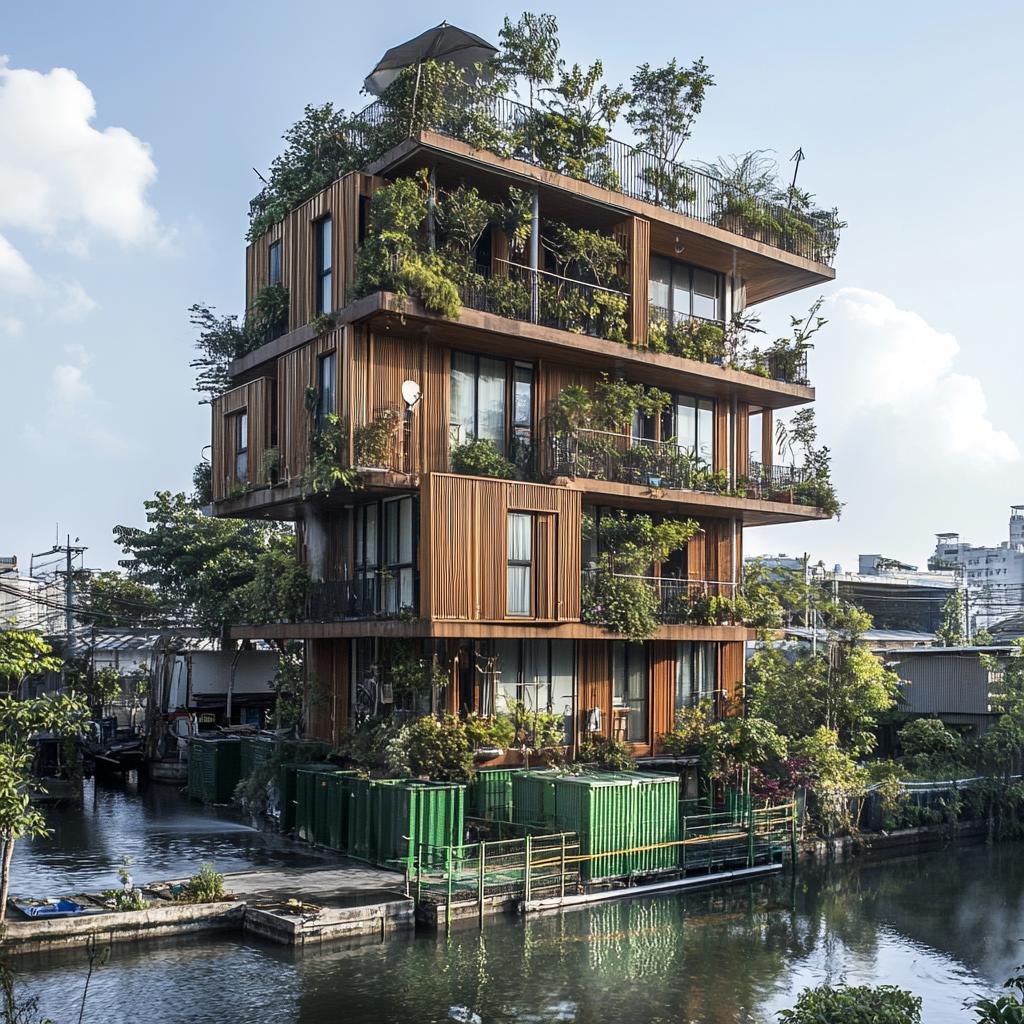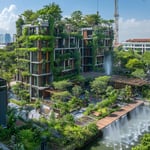In the bustling realm of urban development, The Muve Bangwa project stands as a beacon of environmental responsibility on Soi Petchkasem 38. This ambitious endeavor, unfolding as an 8-story residential building, is rife with challenges, not the least of which is the notorious PM2.5 dust pollution. With a steely commitment to ecological mindfulness, the developers left no stone unturned in their adherence to the strictures laid out in Ministerial Regulation No. 4 (B.E. 2526) and its successors, as well as every jot and tittle of the Environmental Impact Assessment (EIA) report.
To grapple with the persistent PM2.5 problem, the operator has marshaled a veritable arsenal of dust-busting techniques. Encompassing the site like a gleaming fortress is a solid fence, soaring at least 6 meters high, shielding the environs from errant particles. Meanwhile, a mesmerizing dance of mist sprayers perpetuates throughout the workday, as if to serenade the air with freshness. Transport within these battlements is a ritualistic affair; truck wheels undergo a baptism of cleanliness before they depart the site, ensuring no speck of dust breaches the perimeter. As the pièce de résistance, a state-of-the-art PM2.5 monitoring device reigns supreme, its front-mounted display keeping residents abreast of air quality with the precision of a Swiss watch.
Beyond this bastion of innovation, the Deputy Governor drives home the imperative of tidiness at the project’s threshold. Not a grain of sand nor a droplet of cleaning water is to stray into public drainage systems—a decree underscoring the district’s staunch resolve to prevent environmental encroachments. Rigorous inspections of truck emissions complement this directive, binding operators to standards that leave black smoke as a relic of history.
In a harmonious juxtaposition, the district’s urban landscape is rejuvenated at Wat Paknam Phasi Charoen, also cherished as Kanchanaphisek Park. This verdant enclave, flanked on all sides by three tranquil canals—Phasi Charoen, Dan, and Bangkok Yai—has undergone a stunning transformation. Benches, now gleaming with fresh paint, invite reflection beneath the canopy of newly planted trees. As the gentle breeze whispers through foliage, one cannot help but marvel at the visionary Pocket Park project, paying homage to His Majesty the King’s 72nd celebration with the creation of 72 parks.
Of the nine ’15-minute parks’ currently enlivening the district, tantalizing highlights await at the “Smile Park and Wellness Area” and Wat Pradu Bangchak Park, spaces infused with potential for vibrant community gatherings. Spurred by the Governor’s dynamic vision, plans unfurl to develop even more of these sanctuaries, where nature and humanity might flourish side by side.
In a masterstroke of civic innovation, Ban Klang Mueang Sathorn-Kalpapruk emerges as a paragon of waste management. This community, spanning a generous 1,484 square wah and housing 140 residents, champions waste separation with meticulous grace. Organic refuse finds its rest in green bins, while recyclables dwell within secure cages, awaiting collection. Meanwhile, specially marked containers usher hazardous materials toward their safe disposal.
These efforts, orchestrated under the watchful eye of the Deputy Governor, translate sorted waste itself into currency for recalibrated waste management fees—an enticing motivation toward waste subjugation. In this same vein, commercial areas endure scrutiny, with 123 vendors scattered across seven zones, their orderliness ensured by vigilant oversight.
Indeed, the district’s endeavors paint a portrait of Phasi Charoen as a crucible of environmental excellence and urban ingenuity. Through foresight and action, its leaders chart a course that interweaves meticulous planning with the vibrant thread of practical implementation. The canvas that emerges is one of a community poised to embrace a future where environmental stewardship is a given, not a goal.


















This is incredible! Finally, a project that prioritizes the environment over reckless development. Bangkok desperately needs more of these initiatives.
It’s a start, but can it really overhaul the city’s dreadful pollution levels? I’m skeptical.
Skepticism is fair, but every effort counts. If more projects follow suit, it could lead to substantial change.
Exactly, we need leaders willing to push for sustainable cityscapes.
I’m concerned about the costs associated with these developments. Will it lead to a hike in property prices? Gentrification could push out locals.
Good point, Tony. Developers often disregard the community’s needs.
But at what point do we prioritize the environment over short-term financial concerns? Costs aside, the health benefits are invaluable.
Agreed, health is crucial. It’s a tricky balance that needs conscientious planning.
These parks are lovely ideas! Urban green spaces are more than just a luxury; they’re a necessity for mental health.
Definitely. Parks provide a breath of fresh air in a concrete jungle. Happy to see Bangkok making this a priority!
Absolutely, especially in a city as densely populated as ours.
Sometimes I feel like governments just plant a few trees and call it a day. This project seems far more involved, thankfully.
What’s with the fencing and mist spraying? Isn’t the pollution problem just a bigger issue to tackle?
I think it’s part of a larger strategy to control construction dust specifically. Small efforts contribute to larger progress.
Oh, that makes sense. I hope they have more plans beyond just dust.
Construction sites are notorious polluters. This kind of attention to environmental detail is necessary.
Feeling impressed with the community’s waste management efforts. Why can’t more neighborhoods adopt similar practices?
Education and motivation are key. When people see a direct benefit, like reduced fees, they engage more willingly.
True, but some areas lack the resources to implement such systems.
Does anyone else think this sounds too good to be true? I’d like to see the results after a year or two.
I’m more excited about the new parks than anything else. Pretty tired of the concrete everywhere.
Phasi Charoen is leading by example. Other districts should take note!
It’s easier said than done. Political will and funding are major roadblocks.
True, but pressure from citizens can help push these issues forward.
Exactly! Starting small can lead to big change.
Nice to see progress, but skeptical about actual environmental impact. Is it enough to make a noticeable difference?
I’m thrilled about dust-free construction, but continuous updates on air quality seem like overkill to me.
On the contrary, real-time data is empowering for the community. Knowledge is power.
I hope this creates jobs for local residents. Sustainable development can be a win-win.